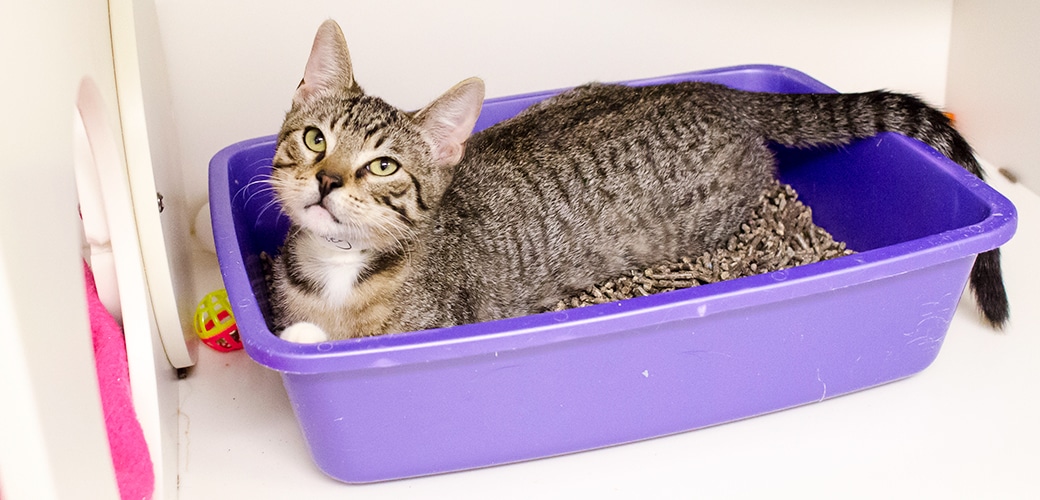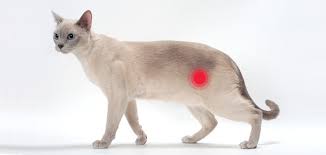-
Adopt
-
Veterinary Care
Services
Client Information
- What to Expect – Angell Boston
- Client Rights and Responsibilities
- Payments / Financial Assistance
- Pharmacy
- Client Policies
- Our Doctors
- Grief Support / Counseling
- Directions and Parking
- Helpful “How-to” Pet Care
Online Payments
Emergency: Boston
Emergency: Waltham
Poison Control Hotline
-
Programs & Resources
- Careers
-
Donate Now
![]()
 x
x
Katherine McKean, DVM
angell.org/emergency
emergency@angell.org
617-522-7282
April 2025
x
xx
Feline idiopathic cystitis (FIC) is a syndrome characterized by inflammation of the urinary bladder in the absence of a known underlying cause. It is the most common cause of lower urinary disease in household cats, and the most common precipitating cause of urethral obstruction in male cats. Given its prevalence, FIC accounts for a significant portion of sick visits to veterinary clinics and represents an important opportunity for improving patient wellbeing.
most common cause of lower urinary disease in household cats, and the most common precipitating cause of urethral obstruction in male cats. Given its prevalence, FIC accounts for a significant portion of sick visits to veterinary clinics and represents an important opportunity for improving patient wellbeing.
Cats with FIC typically present with recurrent episodes of self-limiting lower urinary signs. The most common signs are difficulty or pain when urinating, frequent urination in small amounts, blood in the urine, and inappropriate urination outside of the litterbox. An identifiable “stressor” may precipitate signs, though an inciting event is not always clear. Acute episodes of FIC often resolve spontaneously within a few days of onset, but chronic or recurrent signs are common, making long-term management important.
Accurate diagnosis of FIC requires a thorough workup to rule out other potential causes of lower urinary tract disease. Though cats with transient, infrequent signs can often be treated empirically, cats presenting with frequent, persistent, or severe signs should be worked up further to ensure appropriate care. Diagnostic steps should include urinalysis +/- urine culture to rule out bacterial cystitis, bloodwork to assess kidney function and screen for contributing systemic disease, and imaging with ultrasound or radiographs to assess for bladder stones, tumors, or other structural abnormalities. In cats with FIC, urinalysis is typically consistent with sterile inflammation, often showing a combination of crystalluria, hematuria, leukocyturia, and proteinuria, and imaging will appear normal or show generalized bladder wall thickening. In cases where ultrasound has found abnormalities, or cases of severe, persistent symptoms where other causes are not identified, referral for cystoscopy may be considered to screen more closely for tumors, strictures, bladder wall lesions, bleeds originating from the kidneys or urethra, or other conformational abnormalities. If no underlying etiology can be found, FIC can be diagnosed.
While we don’t fully understand FIC’s pathogenesis, several key mechanisms are thought to contribute.
Bladder Mucosal Dysfunction
The bladder wall in cats with FIC often shows evidence of inflammation, particularly in the urothelium, along with decreased glycosaminoglycan layer integrity. The urothelium normally acts as a protective barrier, and damage or functional impairment of this barrier increases bladder permeability, allowing irritating substances to penetrate the bladder wall and trigger an inflammatory response.
Neurogenic Inflammation
 Stress-induced changes in the autonomic nervous system and neurogenic inflammation can alter the sensation and motility of the bladder. Bladder sensory nerves are responsible for sensing noxious stimuli and transmitting pain signals to the brain. In FIC, increased activity of these sensory nerves results in heightened bladder sensitivity and discomfort.
Stress-induced changes in the autonomic nervous system and neurogenic inflammation can alter the sensation and motility of the bladder. Bladder sensory nerves are responsible for sensing noxious stimuli and transmitting pain signals to the brain. In FIC, increased activity of these sensory nerves results in heightened bladder sensitivity and discomfort.
Stress and Environmental Factors
Stress is thought to be a significant contributing factor to the development and recurrence of FIC. Cats are highly sensitive to changes in their environment, and factors such as intra-cat conflict, boredom or lack of enrichment, and changes in routine may trigger FIC episodes. Stress can influence the neuroendocrine environment, affecting bladder function, increasing bladder sensitivity, and exacerbating symptoms.
Management of FIC is often multifaceted, involving symptomatic treatment for acute episodes and strategies to prevent recurrence.
Treatment of acute episodes should include pain management. While NSAIDs are sometimes used cautiously in cases with significant inflammation and discomfort, they should be avoided in cats with renal disease. Opioids like buprenorphine are helpful for pain management in the acute phase, often complemented by adjunctives such as Gabapentin.
Dietary management can play a role in supporting bladder health. Prescription diets formulated to reduce inflammation may be beneficial in managing some cases of FIC. Good hydration can help dilute urine and reduce irritation. Encourage increased water intake by offering wet or wetted food and ensuring access to clean water. Some cats prefer water fountains or bubblers to standing water bowls.
Reducing stress is an essential goal for long-term management of FIC. Encourage meaningful social interaction between cats and caregivers. Interactive toys, particularly those encouraging predatory play behavior, may help reduce boredom. Consider pheromone sprays or diffusers to reduce anxiety in the home. In multi-cat households, provide vertical spaces like cat trees and hiding spots to reduce territorial stress. Ensure each household cat has easy access to clean, appropriate-sized litter boxes. If possible, provide one litterbox for every household cat plus one extra. If owners can anticipate upcoming stressful events — travel, visitors, introduction of new pets, or significant changes in routine — consider pre-treating with anxiolytic medications.
In cases of frequent or chronic FIC, additional interventions may be needed. Additionally, anxiolytics or antidepressants may be considered for cats with persistent symptoms despite environmental modifications. Consultation with a veterinary behaviorist can be considered for these patients.
For cats without urinary obstruction, the prognosis for FIC is generally good, as most cats recover completely from acute episodes. However, it is essential to educate owners about the importance of close, careful monitoring for cats with FIC, particularly male cats. At its worst, FIC can cause a complete urinary obstruction and quickly become life-threatening. For any cat experiencing lower urinary signs, owners should be advised to monitor urine output closely and seek emergency care if their cat is straining unsuccessfully or not producing urine as expected.
Feline idiopathic cystitis remains a challenging disease with a significant impact on our patients. With proper care, many cats with FIC can lead normal lives, though long-term management may be needed to prevent recurrence and ensure optimal quality of life. While further research may expand our understanding of this disease and offer more targeted therapies, for now, the combination of a preventative and symptomatic approach remains the cornerstone of managing this complex and often recurrent disease.
References
- Buffington, C A T. “Idiopathic cystitis in domestic cats–beyond the lower urinary tract.” Journal of veterinary internal medicine 25,4 (2011): 784-96. doi:10.1111/j.1939-1676.2011.0732.x
- Defauw, Pieter A M et al. “Risk factors and clinical presentation of cats with feline idiopathic cystitis.” Journal of feline medicine and surgery 13,12 (2011): 967-75. doi:10.1016/j.jfms.2011.08.001
- Forrester, S Dru, and Todd L Towell. “Feline idiopathic cystitis.” The Veterinary clinics of North America. Small animal practice 45,4 (2015): 783-806. doi:10.1016/j.cvsm.2015.02.007
- He, Chengxi et al. “Prevalence, Risk Factors, Pathophysiology, Potential Biomarkers and Management of Feline Idiopathic Cystitis: An Update Review.” Frontiers in veterinary science 9 900847. 21 Jun. 2022, doi:10.3389/fvets.2022.900847
- Piyarungsri, Kakanang et al. “Prevalence and risk factors of feline lower urinary tract disease in Chiang Mai, Thailand.” Scientific reports 10,1 196. 13 Jan. 2020, doi:10.1038/s41598-019-56968-w